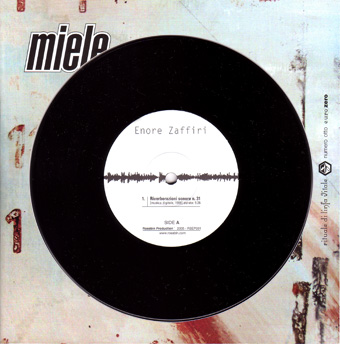"Riverberazioni Sonore"

SIDE
A:
Riverberazioni Sonore n° 31
(05:26:00)
Recorded in Torino / Year 1998
SIDE B:
Sonetto CXLIV (02:37:00)
Recorded in Torino / Year 1973
Riverberazioni Sonore n° 31 02:59:00
Recorded in Torino / Year 1998
Enore Zaffiri was born in Turin on March 29,
1928. He studied in Turin at the "Conservatorio G. Verdi",
taking a diploma in composition, choral music and pianoforte, and subsequently
in Paris at the "Conservatoire National" with Tony Aubin.
He perfected his piano studies with Guido Agosti in Siena at the "Accademia
Musicale Chigiana". From 1954 to 1982 he held the Chair of General
Music Culture at the "Conservatorio G. Verdi" in Turin.
As a composer he won various awards. In 1964, he turned his interest
to electronic music and founded SMET (Studio di Musica Elettronica di
Torino) which made its headquarters in Turin at the Conservatorio, and
he also became a lecturer in this subject.
Zaffiri’s first objective was to overcome the historical elementary
principles which coordinated the relationships between the sounds of
traditional musical language for acoustic instruments and then concentrate
his efforts on electronic means, searching for new sound perspectives
originating from a structural principle based on the Euclidian plane
geometrical figure by which means the various sound parameters can be
coordinated and the formal and spatial dimension extracted.
In 1965, together with other operators in the visual field, he set up
the Studio di Informazione Estetica and started an interdisciplinary
research into sound and visual phenomena.
The main objective of the research was to generate the elements relevant
to the sound and visual fields from a single basic structure. The extreme
limit of the formal rigorism was achieved in 1968 with the project Musica
per un anno, the purpose of which was the sonorization of environments.
From 1970, Zaffiri turned his attention towards the live performance
of electronic music. He combined electronic sound with the human voice
- sometimes crossing the border into total theatre (Il giuoco dell’oca
from the novel by E. Sanguineti and Raptus based on a text by M. Châtel).
In the period, the first scores for synthesizers appeared, permitting
the live performance of pieces specifically written for this instrument.
At the end of the seventies, he extended his research into visuals to
the video, maintaining the interdisciplinary process using the instruments
that technology offered and which represented, for the author, the means
and support for what he intended to express.
At the end of the eighties, he produced the video L’arte nella
Storia published by Cooperativa Books and Video in Turin.